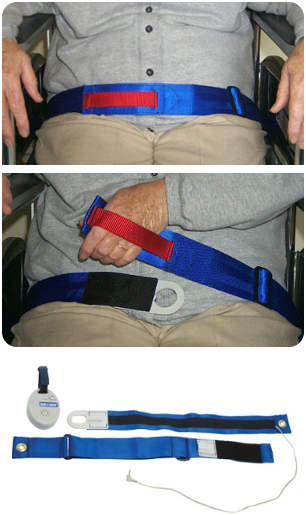As people age, their bones become more frail and balance slowly declines. Although you can be the most fit person in the community, old age takes its toll on overall health. If you, or a loved one, has a chronic disease or injury that requires wheelchair assistance, a belt alarm enhances the chair’s safety level. Among many of its purposes, belts stop potential falls to keep loved ones free from further injury.
How It Works
A wheelchair belt alarm is actually a simple circuit that can alert attendants if a person unbuckles the harness. An alarm unit attaches to the wheelchair’s backrest, out of reach for the chair user. The belt connects to the alarm unit as it wraps around the person. Once buckled, the circuit is complete, signalling the alarm to remain quiet. When the circuit is broken by unlatching the buckle, the alarm sounds.
Wheelchair belts are not meant to be restraints, so the buckle is an easy-to-open mechanism. The user should still be able to unbuckle the belt in cases of accidents, such as a tipped over chair. A buckle that is difficult to unlatch could lead to severe injuries for the restrained person.
Imagine this scenario. You are taking care of your father who is in a wheelchair. But he always wants to do things on his own. You step away to cook a meal. All it takes is a moment for an accident to occur. Your father tries to reach for an item and falls out of the wheelchair, injuring their head and becoming unconscious. Without this belt, you would still be cooking a meal unaware of the tragedy that just occurred. If you used a wheelchair belt alarm, your father would have been reminded to stay in their wheelchair and wait for assistance, while an alarm would have alerted you that your father is out of the wheelchair. A few extra minutes can save a life.
Benefits And Application In The Home
 Although these belts appear to have more use in a hospital or convalescent environment, they easily enhance the home experience. For example, patients with dementia or Alzheimer’s may not be mentally capable of understanding their peril if they move from their wheelchair. Alarm belts notify caregivers immediately if the person is trying to stand or walk away from their chair.
Although these belts appear to have more use in a hospital or convalescent environment, they easily enhance the home experience. For example, patients with dementia or Alzheimer’s may not be mentally capable of understanding their peril if they move from their wheelchair. Alarm belts notify caregivers immediately if the person is trying to stand or walk away from their chair.
Other patients, who are otherwise mentally-capable, may simply be stubborn about their wheelchair needs. Refusing to wait for a caregiver and standing on their own, patients increase their chances of falling and breaking a bone. In the elderly years, a broken hip could lead to more serious injuries. Keeping a loved one in the wheelchair until assistance arrives preserves their current health.
Average Cost
Most alarm belts sell between $100 and $200. It may be possible to negotiate with your loved one’s health insurance to see if some of the cost can be offset with insurance funds. Especially for mental conditions, it is more cost-effective for health insurance to pay for an alarm belt than for medical costs associated with a fall from a wheelchair. Talk to your health insurance provider to see your options.
- Recommended Wheelchair Belt Alarms– This belt alarm is made of strong nylon and has a velcro for easy belt removal. The alarm is a 95dB horn sound.
Avoid buying a used or heavily discounted alarm belt. There may be mechanical or electronic issues with the belt. You do not want to compromise on quality when it comes to patient safety.
Maintenance Is A Daily Affair
In general, alarm belts use simple electronic circuits to generate a loud signal. Maintenance is key to keep the belt in working order, however. For many units, an LED, or light-emitting diode, illuminates on the alarm unit. This light indicates that the unit is working normally. If the light doesn’t illuminate, a new battery may be necessary.
Check your manual to see if the unit has a test button. If a button exists, test the belt each day by pressing the button. It tests the alarm function and battery at the same time. If there is any hesitation, replace the battery promptly. Most units take one or two batteries, such as 9 volt or AA batteries.
Keep your loved ones safe with a wheelchair alarm belt. Explain the belt’s purpose to the patient to help them understand its purpose. With good reasons, many patients welcome the alarm to keep them safe. Although some people may not be excited by the idea, the belt protects patients from exacerbating a condition or severely injuring themselves.
